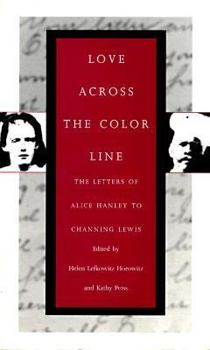Love Across the Color Line
Select Format
Select Condition 
Book Overview
This work examines the collection of 27 letters written by a white woman to her African American lover in 1907 and 1908. The letters, which were hidden for over 80 years, provide a different... This description may be from another edition of this product.
Format:Paperback
Language:English
ISBN:1558490248
ISBN13:9781558490246
Release Date:May 1996
Publisher:University of Massachusetts Press
Length:160 Pages
Weight:0.60 lbs.
Dimensions:0.5" x 5.5" x 9.0"
Customer Reviews
1 rating
important history in a lace stocking
Published by Thriftbooks.com User , 19 years ago
While renovating an old house, a person found a lace stocking filled with love letters from a woman to a man. Also enclosed is a photo of a black woman. Instead of being correspondence between two blacks, it turns out that these letters were written by an Irish-American woman to her black male lover. History buffs and amateur genealogists should love this book. Outside of the interracial context, this book answers how do you find more information when you come upon a historical artifact. The answer is to look at old census documents, old maps, old magazines. Also, let people know what you found and see if someone may know helpful third parties. Just as modern techniques show that we leave our DNA everywhere, for approximately 150 years or so, Americans have left photographs and writings everywhere. Your reality can be found, even a century after the fact. The editor of this book said that the contributors knew this book must be a collaboration from the start. I actually think a historian with a background in women's history, African-American history, and local Massachusetts history could have written this book all by her- or himself. The extant letters were written by Alice to Channing; there is no existing two-way correspondence here. However, the book stated that when relationships fell apart, women often asked their paramours for their letters back. So while I thought that Channing may have kept these letters, it was actually Alice who did so. In that same vein, the book uncovers much more about Alice than Channing. In fact, it stands out that the chapter devoted to her is deep whereas the one devoted to him is scant. Still, you gotta work with whatcha got. This book is inspiring in that it proves such relationships did exist before Loving v. Virginia. However, that is where the inspiration ends. This relationship was riddled with abuse, jealousy, "gold digging," and misogyny. Just as Frederick Douglass wed a different white woman than the one to whom he wrote love letters, Channing never divorced his white wife to marry Alice. Patricia Hill Collins has soundly condemned the idea that this pairing is Root's "love's revolution." That stands out here. In fact, modern census figures show that couples co-habit interracially much more than they wed interracially. While this book does mention Smith College at several points, it never brings up that Northampton is now nicknamed "Lesbianville, USA" by its own residents. Greenwich Village was known for its tolerance toward interracial couples and gay couples. The authors here never state whether Northampton residents of that era would have been equally open-minded. This book does leave some questions unanswered. Alice was 32 when she wrote to Channing and 40 when she married another man. Did she pursue Channing because she didn't want to be an "old maid"? Channing was obviously literate, but the authors never suggest how he learned to read. They mention several times tha





